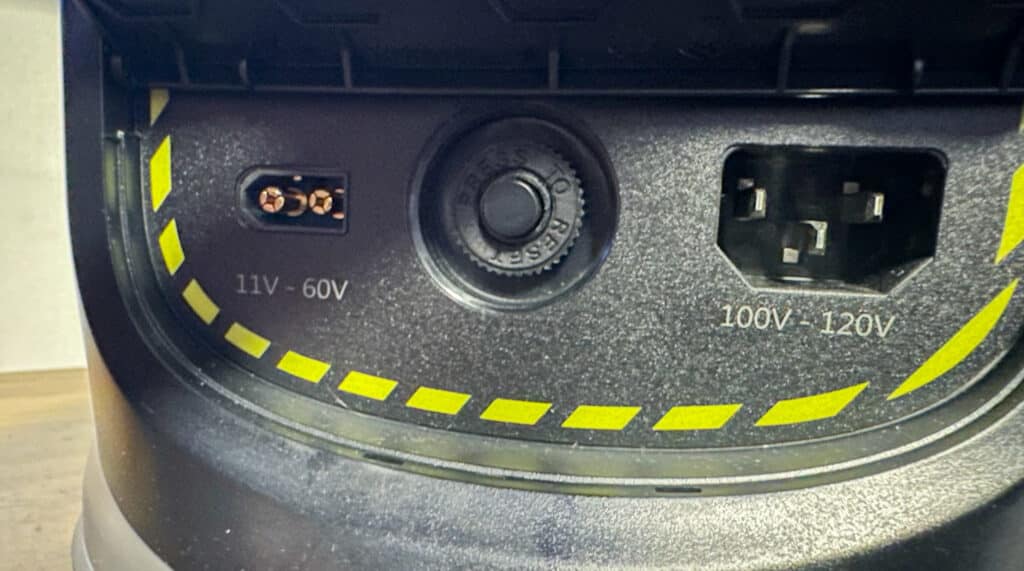Ampace Technology introduces the innovative Andes 1500 portable power station designed for functionality and reliability. And it has some pretty cool, functional lights on top.
We recently received Ampace Technology’s latest innovation, the Andes 1500 portable power station. Known for its cutting-edge energy solutions and expertise in lithium-ion battery technology, Ampace provided us with a unit to evaluate its features, performance, and overall user experience.
Advanced Battery Technology
At the core of the Andes 1500 is automotive-grade battery cell technology, a testament to Ampace’s collaboration with battery industry leaders ATL and CATL. This joint venture brings over 20 years of battery expertise, culminating in a power station with an impressive 1462Wh capacity and a lifespan of up to 6000 cycles. Utilizing LiFePO4, the Andes 1500 offers a compact package of substantial and reliable power storage. Check out our recent review of the Andes 600.
Ampace currently has a sale for $400USD off the Ampace Andes 1500 on their website, $999

Designed for reliability in extreme conditions, the Andes 1500 maintains over 80% of its capacity at temperatures as low as -20°C (-4°F). This durability is achieved through the integration of Silicon Carbide (SiC) and a Digital Signal Processor (DSP)-controlled high-frequency bidirectional Power Conversion System (PCS), delivering inverter efficiency of up to 95%.
Versatile Charging Options
Ampace’s A-Boost fast charging offers multiple methods to keep the battery topped up; supporting up to 1,800W grid charging, 600W solar charging, and 96W car charging. This flexibility ensures the Andes 1500 can be rapidly and efficiently recharged no matter the situation.
There is also an expansion port for chaining together multiple batteries, expected to be released in 2025.
User-Centric Design
The Andes 1500 design offers thirteen output ports, including AC, DC, car socket, USB-C, and USB-A( 4 AC ports, 2 100W USB-C ports, 4 18W USB-A ports, 2 120W DC ports, and a 120W car outlet.) . Ampace’s advanced Battery Management System (BMS) optimizes battery performance, is claimed to extend its lifespan by up to 50%, and identifies internal short-circuit risks, ensuring safety and longevity.
Users can control and monitor the Andes 1500 via the Ampace mobile app, which connects seamlessly through Bluetooth and Wi-Fi. The app delivers an enhanced user experience, allowing users to check power levels, customize settings, adjust ambient RGB lighting, and manage temperature. The main interface offers straightforward control and monitoring of inputs and outputs. At the same time, the settings section includes Wi-Fi connection information, RGB light settings, A-Boost for high-current motor starts, and other timeout features. Refer to our Andes 600 Pro review for more info on the app integration.
Living With the Ampace Andes 1500
Setting aside the spec sheet, the Ampace Andes 1500 is an impressive power station. We like to review power stations slowly to truly experience their performance, and this one was a pleasant surprise from the start. It arrived at our edge lab well-packaged and in perfect condition.
Continuing with the theme from the Andes 600 we recently reviewed, the 1500 also has the same RGB strip on the top. The top ring’s killer feature is its ability to display charge status from across the room. When fully charged, it pulses green—a seemingly minor feature but surprisingly helpful. The Ampace App allows you to customize this ring with different patterns for a subtle ambient light, and in dark or low-light settings, it’s both functional and discreet. If you prefer, this feature can be completely disabled.
The unit feels fairly well built and was able to handle a small (unintentional) drop during the testing cycle out of the back of a car. Aside from the cosmetic scrapes, there was no other damage to the unit. The adjustability of the charging rate is in the setting of the application, which is nice if you don’t have an outlet or circuit that can handle the fast charging.
Tested
| Ampace Andes 1500 Specifications | |
|---|---|
| Battery Capacity | 1462Wh |
| Battery Life Cycle | Up to 2000 cycles |
| Output Ports | AC(2400W with 3600W Surge), DC, Car Socket, USB-C, USB-A |
| Grid Charging | 1800W (adjustable down to 900W) |
| Solar Charging | 600W |
| Car Charging | 96W |
| Weight | 16.5Kg/36.4LB |
| Discount | 20% off on Amazon with code 20VFP648 |
Testing the Ampace Andes 1500
We always like to push these systems to their limits, testing from a full charge to zero and back up to 100% to compare against the specs. We conducted several cycles straight out of the box and again after a few weeks of use. The results were within the expected margin of error. On average, the Ampace Andes delivered and average of 1,184Wh of power and required 1,585Wh to recharge. This performance is at the edge of the expected 80% efficiency but meets the standard.
We respect the 80% efficiency rating, considering it a pass for this test, as it accounts for thermal and inverter efficiency losses. Running USB-C or using the 12V output can yield even better results.
Conclusion
We love the RGB strip at the top. It is not just a gimmick—it’s a well-implemented feature, and we think it’s one of the best features of Ampace’s Andes line.
The Ampace Andes 1500 introduces another exciting feature to the portable power station market. This power station stands out with its advanced battery technology, versatile charging options, and user-focused design. Its reliability in extreme conditions and intelligent management system make it an excellent choice for anyone needing a dependable and efficient portable power solution.
Whether you need a power station for emergencies, camping, or to keep your devices charged, the Andes 1500 is a top pick. Ampace has created a product that is both well-made and highly functional. So, set aside your doubts, charge up your devices, and embrace the future of portable power. And yes, enjoy the pretty lights while you’re at it.
Engage with StorageReview
Newsletter | YouTube | Podcast iTunes/Spotify | Instagram | Twitter | TikTok | RSS Feed





